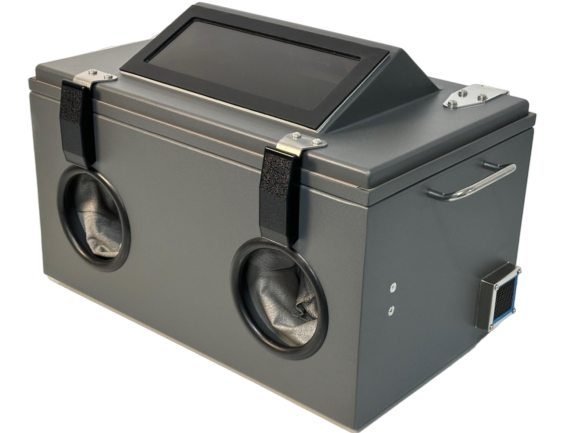What Is a Faraday Box?
A Faraday box is a specialized enclosure designed to block electromagnetic fields (EMF), preventing wireless signals from entering or leaving the container. Named after Michael Faraday, the scientist who discovered the principles of electromagnetic shielding, these boxes serve as the ultimate defense against electronic eavesdropping, signal interference, and wireless hacking threats.
How Does a Faraday Box Work?
A Faraday box operates based on the principles of electromagnetic shielding. It is typically made of conductive materials such as copper, aluminum, or steel, which redirect and absorb electromagnetic radiation. This prevents radio frequency (RF) waves, Wi-Fi, Bluetooth, GPS, and cellular signals from penetrating the shielded environment inside the box.
Key Components of a Faraday Box
- Conductive Metal Layer – Acts as a shield against EMF radiation.
- Sealed Enclosure – Ensures that no gaps allow signals to escape or enter.
- Insulating Lining – Protects internal devices from direct contact with the conductive material.
- Secure Latches or Locks – Reinforces physical security to keep devices safely enclosed.
Why Do You Need a Faraday Box?
As technology advances, so do the threats associated with wireless hacking, GPS tracking, and RFID skimming. Here are some reasons why you should consider investing in a Faraday box:
1. Protection Against EMP and Solar Flares
A Faraday box can shield sensitive electronic devices from electromagnetic pulses (EMP) caused by natural solar flares or man-made attacks. An EMP could cripple power grids and disable electronics, making Faraday shielding essential for preparedness.
2. Preventing Car Theft (Key Fob Hacking)
Modern vehicles use keyless entry systems, which are vulnerable to relay attacks. Criminals can amplify the signal of your car key fob, tricking your vehicle into unlocking and starting without your knowledge. Storing your key fob inside a Faraday box prevents this type of theft.
3. Blocking RFID and NFC Signals
Credit cards, passports, and access badges use RFID (Radio Frequency Identification) and NFC (Near Field Communication) technology, which can be wirelessly skimmed by hackers. A Faraday box prevents unauthorized scanning, ensuring your sensitive data remains secure.
4. Cybersecurity and Privacy Protection
Government agencies, corporate executives, and individuals concerned about data security use Faraday enclosures to prevent their devices from being accessed remotely. Mobile phones, laptops, and tablets can be protected from spyware, remote hacking, and signal interception by storing them in a Faraday box.
5. Eliminating Signal Interference
In research laboratories and secure environments, Faraday cages help prevent external electromagnetic interference (EMI) from affecting sensitive equipment. This is critical for accurate scientific experiments, medical devices, and secure communication systems.
Types of Faraday Boxes
There are different types of Faraday enclosures available, depending on the level of protection needed:
1. Portable Faraday Bags
- Ideal for mobile phones, wallets, and small electronics.
- Easy to carry and designed for daily use.
- Often used for travel security and key fob protection.
2. Large Faraday Storage Boxes
- Designed to store laptops, tablets, and larger electronic devices.
- Used by businesses and law enforcement agencies to secure confiscated devices.
- Common in high-security government operations.
3. Faraday Cages for Rooms or Buildings
- Large-scale enclosures that shield entire rooms or buildings.
- Used in military, research, and medical facilities.
- Protects against strong EMP attacks and RF surveillance.
How to Build a DIY Faraday Box
If you want to create a homemade Faraday box, follow these steps:
Materials Needed:
- A metal container (such as an ammo box or a metal tin)
- Aluminum foil (multiple layers for better shielding)
- Copper mesh or conductive fabric
- Rubber or foam lining (to insulate electronics from direct contact with the metal)
- Duct tape (to seal edges)
Step-by-Step Instructions:
- Line the Interior – Cover the inside of your metal box with an insulating material like rubber or foam to prevent direct contact between electronics and the metal surface.
- Wrap the Exterior – Apply multiple layers of aluminum foil around the container for additional shielding.
- Ensure a Tight Seal – Use duct tape or a conductive gasket to close any gaps where signals could penetrate.
- Test the Box – Place your smartphone inside, close the lid, and try calling it. If the call does not go through, the Faraday box is working.
Buying the Best Faraday Box: What to Look For
If you prefer to buy a professionally made Faraday box, consider the following factors:
1. Material and Build Quality
- Choose copper or aluminum for high shielding effectiveness.
- Ensure the enclosure has no leaks or open gaps.
2. Size and Capacity
- Determine what devices you need to protect.
- Pick a box that can accommodate phones, laptops, car keys, or larger electronics.
3. Security Features
- Look for reinforced locks or latches to prevent unauthorized access.
- Consider tamper-proof designs for added security.
4. Independent Testing and Certification
- Opt for products tested for EMP and RF shielding effectiveness.
- Brands with lab-certified shielding performance offer more reliable protection.
Final Thoughts
A Faraday box is an essential tool for protecting electronic devices from EMP, cyber threats, and wireless attacks. Whether you need it for personal security, corporate data protection, or survival preparedness, investing in a high-quality Faraday enclosure ensures peace of mind.
For maximum security, choose a reputable Faraday box or build your own with high-quality shielding materials. Don’t leave your devices vulnerable—secure them today with a Faraday box!





























